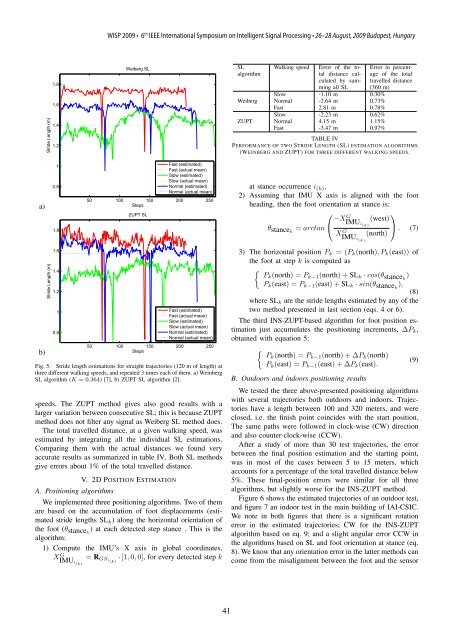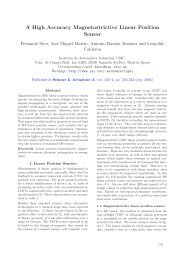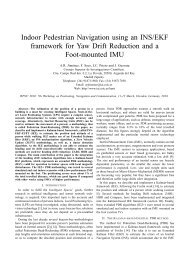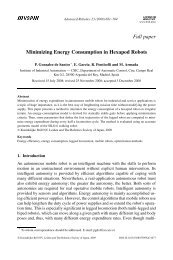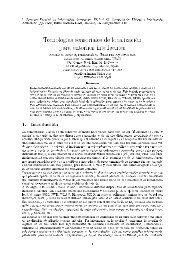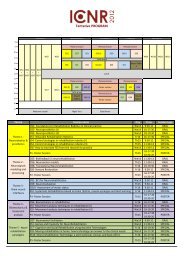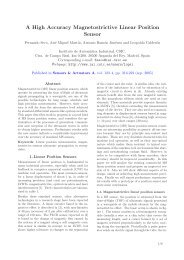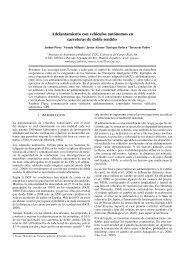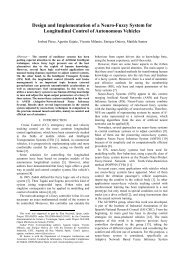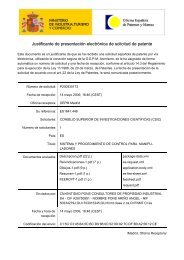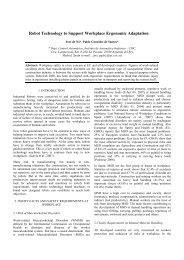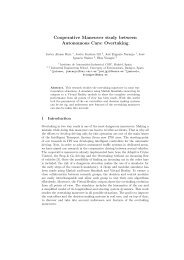A Comparison of Pedestrian Dead-Reckoning Algorithms using a ...
A Comparison of Pedestrian Dead-Reckoning Algorithms using a ...
A Comparison of Pedestrian Dead-Reckoning Algorithms using a ...
You also want an ePaper? Increase the reach of your titles
YUMPU automatically turns print PDFs into web optimized ePapers that Google loves.
WISP 2009 • 6 th IEEE International Symposium on Intelligent Signal Processing • 26–28 August, 2009 Budapest, HungaryStride Length (m)1.81.61.41.2Weiberg SLSLalgorithmWeibergZUPTWalking speedError <strong>of</strong> the totaldistance calculatedby summingall SLSlow -1.10 m 0.30%Normal -2.64 m 0.73%Fast 2.81 m 0.78%Slow -2.23 m 0.62%Normal 4.15 m 1.15%Fast -3.47 m 0.97%Error in percentage<strong>of</strong> the totaltravelled distance(360 m)TABLE IVPERFORMANCE OF TWO STRIDE LENGTH (SL) ESTIMATION ALGORITHMS(WEINBERG AND ZUPT) FOR THREE DIFFERENT WALKING SPEEDS.a)10.81.8Fast (estimated)Fast (actual mean)Slow (estimated)Slow (actual mean)Normal (estimated)Normal (actual mean)50 100 150 200 250StepsZUPT SLat stance occurrence i (k) .2) Assuming that IMU X axis is aligned with the footheading, then the foot orientation at stance is:⎛−X G ⎞IMU(west)i(k)θstance k= arctan ⎝⎠XIMU G . (7)(north)i(k)b)Stride Length (m)1.61.41.210.8Fast (estimated)Fast (actual mean)Slow (estimated)Slow (actual mean)Normal (estimated)Normal (actual mean)50 100 150 200 250StepsFig. 5. Stride length estimations for straight trajectories (120 m <strong>of</strong> length) atthree different walking speeds, and repeated 3 times each <strong>of</strong> them. a) WeinbergSL algorithm (K =0.364) [7], b) ZUPT SL algorithm [2].speeds. The ZUPT method gives also good results with alarger variation between consecutive SL; this is because ZUPTmethod does not filter any signal as Weiberg SL method does.The total travelled distance, at a given walking speed, wasestimated by integrating all the individual SL estimations.Comparing them with the actual distances we found veryaccurate results as summarized in table IV. Both SL methodsgive errors about 1% <strong>of</strong> the total travelled distance.V. 2D POSITION ESTIMATIONA. Positioning algorithmsWe implemented three positioning algorithms. Two <strong>of</strong> themare based on the accumulation <strong>of</strong> foot displacements (estimatedstride lengths SL k ) along the horizontal orientation <strong>of</strong>the foot (θstance k) at each detected step stance . This is thealgorithm:1) Compute the IMU’s X axis in global coordinates,XIMU G = R GSi(k) · [1, 0, 0], for every detected step ki(k)3) The horizontal position P k =(P k (north),P k (east)) <strong>of</strong>the foot at step k is computed as{Pk (north) =P k−1 (north)+SL k · cos(θstance k)P k (east) =P k−1 (east)+SL k · sin(θstance k),(8)where SL k are the stride lengths estimated by any <strong>of</strong> thetwo method presented in last section (eqs. 4 or 6).The third INS-ZUPT-based algorithm for foot position estimationjust accumulates the positioning increments, ΔP k ,obtained with equation 5:{Pk (north) =P k−1 (north)+ΔP k (north)(9)P k (east) =P k−1 (east)+ΔP k (east).B. Outdoors and indoors positioning resultsWe tested the three above-presented positioning algorithmswith several trajectories both outdoors and indoors. Trajectorieshave a length between 100 and 320 meters, and wereclosed, i.e. the finish point coincides with the start position.The same paths were followed in clock-wise (CW) directionand also counter-clock-wise (CCW).After a study <strong>of</strong> more than 30 test trajectories, the errorbetween the final position estimation and the starting point,was in most <strong>of</strong> the cases between 5 to 15 meters, whichaccounts for a percentage <strong>of</strong> the total travelled distance below5%. These final-position errors were similar for all threealgorithms, but slightly worse for the INS-ZUPT method.Figure 6 shows the estimated trajectories <strong>of</strong> an outdoor test,and figure 7 an indoor test in the main building <strong>of</strong> IAI-CSIC.We note in both figures that there is a significant rotationerror in the estimated trajectories; CW for the INS-ZUPTalgorithm based on eq. 9; and a slight angular error CCW inthe algorithms based on SL and foot orientation at stance (eq.8). We know that any orientation error in the latter methods cancome from the misalignment between the foot and the sensor41


